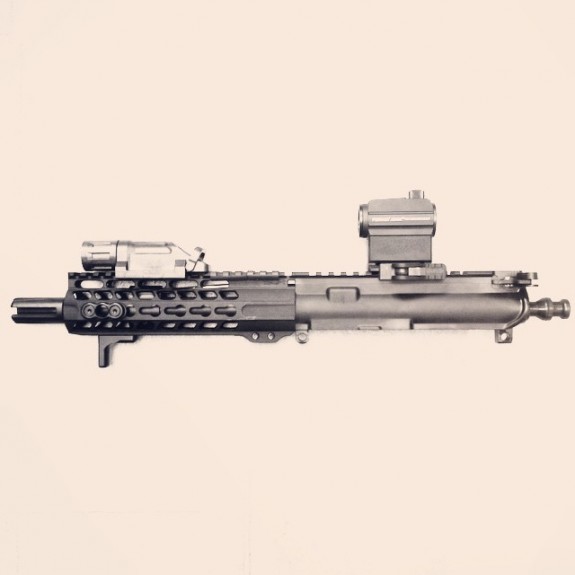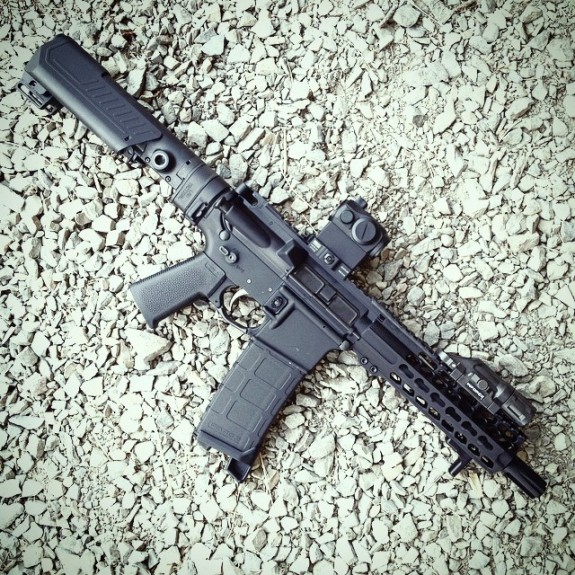This is a followup to my recent post regarding why super short barreled AR-15s chambered in 5.56x45mm are more viable than they used to be thanks to various advancements in projectile design, flash suppressor technology, and more. The article was never intended to say they were the best choice. In fact, I clearly state that other calibers are more efficient in such short barrels but, as usual… the internet overreacted.
One of the more common comments was a variation on the theme of the 5.56 being roughly on par with or only slightly better than a .22LR at the modest velocities produced by 7.5″ barrels. That is the kind of gun counter dogma that makes some sense on its surface because you are giving up some velocity by using such a short barrel and that is not good news for terminal performance. However, this statement just doesn’t hold up with even a cursory examination of the data.
Let’s compare a high velocity .22LR with some 5.56/223 rounds that have shown to be solid performers in shorter barrels. We can compare mass in grains, velocity in feet per second, and energy in foot pounds.
CCI Stinger .22LR
- Mass: 32 gr
- Velocity: 1640 fps
- Energy: 191 ft.lbf
Hornady TAP 5.56 55gr GMX
- Mass: 55 gr
- Velocity: 2340 fps
- Energy: 669 ft.lbf
Winchester Ranger 64 gr 5.56 (RA556B)
- Mass: 64 gr
- Velocity: 2210 fps
- Energy: 694 ft.lbf
Speer Gold Dot 64 gr 5.56
- Mass: 64 gr
- Velocity: 1930 fps
- Energy: 529 ft.lbf
Remington Hog Hammer 62gr TSX
- Mass: 62 gr
- Velocity: 2090 fps
- Energy: 601 ft.lbf
Much of the velocity data came from the poboyspecial Youtube channel.
The data represents just a few of the rounds that perform well from such short barrels. It doesn’t even include a 50 gr TSX load which is considered the gold standard of performance from such short barrels. As you can see, all of the loads sampled here are significantly faster and heavier than 22LR which adds up to significantly more energy. What you can’t see is that all of them exhibit expansion and penetrate well beyond the FBI minimum.
The data shows that, in terms of energy, a well selected .223 or 5.56 round out of a 7.5″ barrel outperforms many .45 ACP and .357 Magnum loads at typical handgun velocities. That really isn’t all that impressive considering that those are handgun loads but it does shows adequate performance for the very limited role you might use such a barrel/ammo combination. When used in a PDW type role, you get a weapon that has extended capacity and usable range beyond a typical handgun, along with fringe benefits likes increased accuracy and ease of accessory mounting (white lights, optics, etc.).
I think it is clear that you the 5.56/.223 is hardly ideal out of such short barrels but to say it is comparable to a .22LR is ridiculous. Choosing a compact package for a specific role is a compromise. You make a similar compromise every time you carry a handgun instead of a rifle. Context is the key.



Careful. Some special people might now say you’re hiding behind ‘data’, which means you’re wrong. People trot out ‘data’ because they don’t have a solid argument.
Except when they do, and you’re right, and where do people get there facts from? It’s knee-jerk reactions like this that get dumb laws instated. It’s knee-jerk reactions like this that create ‘assault weapons’ bans. Well done for using logic and reason, that man.
People trott out “data” when their opinion reflects reality. There is no such thing as biased GOOD data. Only bad data or biased interpretation of good data. Never criticise someone strictly for using data to back up their argument.
No. People use data to back up valid points. People trot out ‘data’, which fall into 2 categories;
Carefully put together statistics meant to mislead OR Half-truths that pass a quick glance but are actually rubbish.
Example;
http://www.dhmo.org/cancer.html
“Detection and Treatment
What is known about these cancers is that Dihydrogen Monoxide is found in detectable and biologically significant levels in virtually all tumors and other cancerous and pre-cancerous growths.
Cancer research has made significant advances in the detection and treatment of many forms of cancers. With each new advancement, the role DHMO plays in the cause of cancer is likely to be better understood.
How Carcinogenic is Dihydrogen Monoxide?
Dihydrogen Monoxide is not believed to be carcinogenic, although it is known to be a component of a number of cancer-causing agents. Additionally, the cause of approximately 20 percent of all cancers is not known, and there is reason to suspect that DHMO may play some role in these as well. Clearly, more research is needed before DHMO’s role is fully enumerated. ”
Everything there is fact. The trick is that DHMO is WATER, and therefore this whol study is pointless and exists to prove the point I am trying to make. Some people will SAY that Matt is hiding behind ‘data’, in the way this stuff is presented.
He isn’t, it’s pretty solid stuff with FBI testing & other independent studies done. Perhaps my sarcasm didn’t translate into American and across the internet.
Context? I don’t have time for context! I’m on the internet!
I was slightly skeptical. I cross-checked your info with a website I love “Ballistics by the Inch” and found that your .22LR number was… “optimistic” even for an 18″ long barrel. I am somewhat surprised, and very glad you posted this.
Why do you feed the trolls? So a few people get their panties in wad, and now you have to post a new article backing up your previous post? Either you’re not effectively backing your original posts or you’re allowing an inferior minority to control your content.
The problem with ignoring trolls is that if you leave their erroneous claims unaddressed, invariably that bad information will make its way into the head of a new shooter who doesn’t know any better. It will anyway, unfortunately, but hopefully now that it has been addressed fewer people will come out believing the bad info.
additional ad revenue
I see that the best performing projectiles are all fairly lightweight. This makes sense; if you have a shorter barrel then you want a light bullet that accelerates quickly. Considering this fact, shouldn’t a 7.5″ AR barrel have a slow twist rate? 1:9 is fairly common, but if you are using 50-55 grain bullets then perhaps even slower rates would be better (comeback of 1:12?).
Excellent followup.
Thank ou.
Good article. Love the shorty. What kind of stock is that?
Taz, The AR pistol shown has no stock. That is a Thordsen Customs Cheek Rest Kit.
The only bad thing is the 5.56 projectile needs to go about 2800 fps in order to deliever the ‘hydrostatic shock’ to the target. So lets be clear that an SBR does loose much effectiveness, but is certainly stronger than a pistol round.